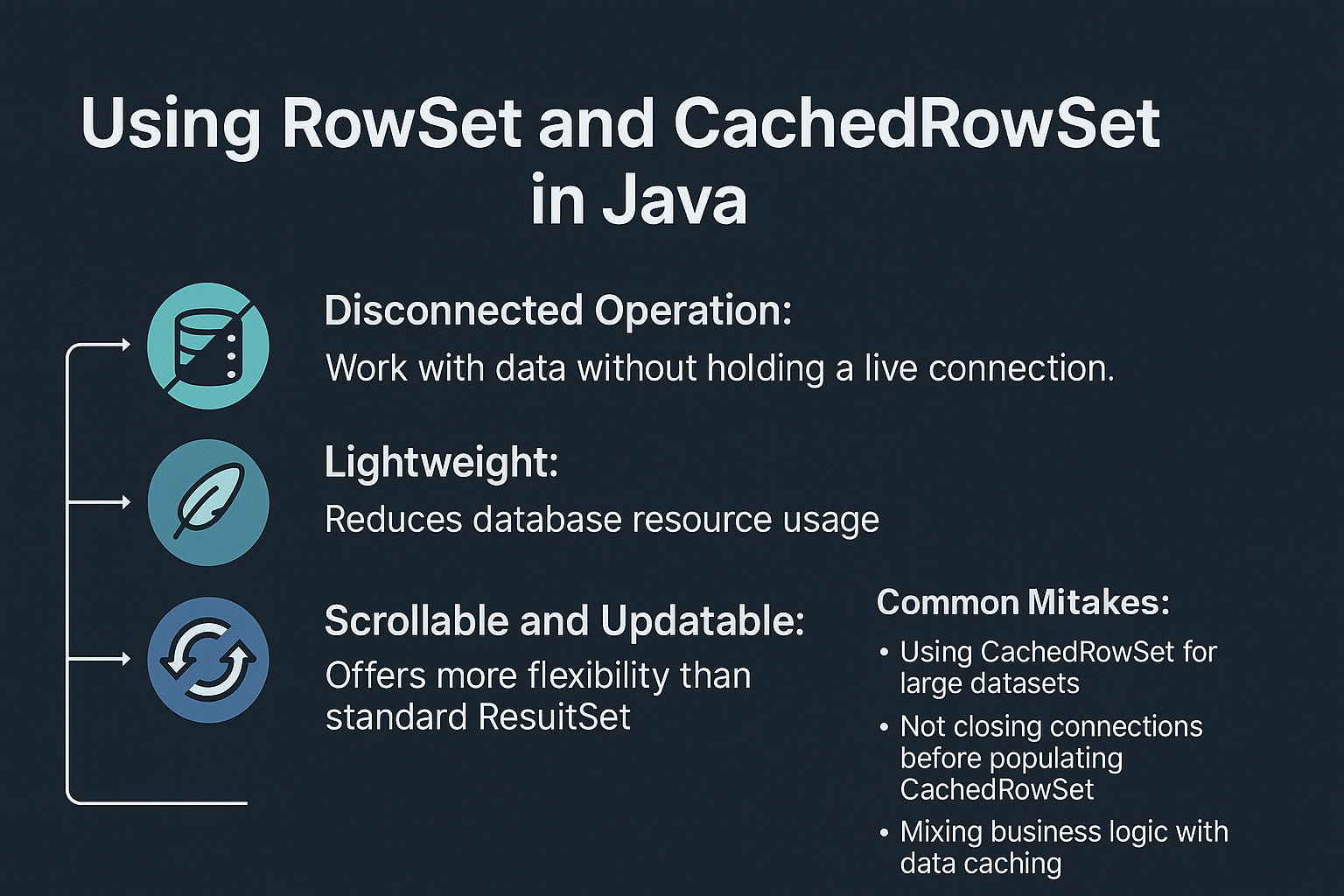Introduction
RowSet and CachedRowSet are advanced JDBC interfaces that provide a more flexible way to work with database results. Unlike ResultSet, which requires an active database connection, CachedRowSet allows disconnected access to data, making it ideal for mobile, desktop, and distributed applications.
Why RowSet and CachedRowSet Matter
- Disconnected Operation: Work with data without holding a live connection.
- Lightweight: Reduces database resource usage.
- Scrollable and Updatable: Offers more flexibility than standard ResultSet.
Core Concepts
What is RowSet?
- A wrapper around
ResultSetwith enhanced functionality. - Can be connected (
JdbcRowSet) or disconnected (CachedRowSet).
What is CachedRowSet?
- A disconnected, serializable version of
RowSet. - Can be sent over a network or saved to disk.
- Ideal for offline data processing.
RowSet Workflow
Java App → RowSet → ResultSet (Connected/Disconnected) → Database
Real-World Use Cases
- Offline Applications: Sync data when reconnected to the database.
- Mobile/Remote Clients: Reduce constant DB connections.
- Reporting Tools: Work with data snapshots.
- Data Caching: Improve performance by caching frequently used data.
Working with JdbcRowSet
Example
import javax.sql.rowset.JdbcRowSet;
import com.sun.rowset.JdbcRowSetImpl;
import java.sql.*;
public class JdbcRowSetExample {
public static void main(String[] args) throws SQLException {
try (JdbcRowSet rowSet = new JdbcRowSetImpl()) {
rowSet.setUrl("jdbc:mysql://localhost:3306/testdb");
rowSet.setUsername("root");
rowSet.setPassword("password");
rowSet.setCommand("SELECT id, name FROM employees");
rowSet.execute();
while (rowSet.next()) {
System.out.println(rowSet.getInt("id") + " - " + rowSet.getString("name"));
}
}
}
}
Working with CachedRowSet
Example
import javax.sql.rowset.CachedRowSet;
import com.sun.rowset.CachedRowSetImpl;
import java.sql.*;
public class CachedRowSetExample {
public static void main(String[] args) throws SQLException {
String url = "jdbc:mysql://localhost:3306/testdb";
String user = "root";
String password = "password";
try (Connection conn = DriverManager.getConnection(url, user, password);
PreparedStatement ps = conn.prepareStatement("SELECT id, name FROM employees");
ResultSet rs = ps.executeQuery()) {
CachedRowSet crs = new CachedRowSetImpl();
crs.populate(rs);
// Work with data offline
while (crs.next()) {
System.out.println(crs.getInt("id") + " - " + crs.getString("name"));
}
}
}
}
Statement vs PreparedStatement vs RowSet
| Feature | Statement | PreparedStatement | RowSet/CachedRowSet |
|---|---|---|---|
| Connection Required | Always | Always | CachedRowSet can work offline |
| SQL Injection Safety | Vulnerable | Safe | Safe |
| Performance | Low | Medium | High for disconnected reads |
| Serialization | No | No | Yes |
Common Mistakes and Anti-Patterns
- Using CachedRowSet for large datasets: Can consume too much memory.
- Not closing connections before populating CachedRowSet: Prevents true disconnection.
- Mixing business logic with data caching: Keep separation of concerns.
Security Implications
- Use PreparedStatement when populating RowSets to prevent SQL injection.
- Ensure secure serialization when transferring CachedRowSet over a network.
Performance and Scalability
- Use CachedRowSet for read-heavy operations with limited writes.
- Avoid holding entire tables in CachedRowSet; use filters or pagination.
- Combine with connection pooling for efficient connected RowSets.
Best Practices
- Use JdbcRowSet for connected, scrollable, updatable data.
- Use CachedRowSet for disconnected, serializable data.
- Always close resources after populating CachedRowSet.
- Test memory usage when working with large datasets.
Real-World Analogy
Think of CachedRowSet as a snapshot of a spreadsheet you can take home and edit offline. When you reconnect, you can sync changes back to the database.
Conclusion & Key Takeaways
- RowSet and CachedRowSet provide flexible data handling beyond ResultSet.
- CachedRowSet enables disconnected operations, ideal for mobile and offline apps.
- Always follow best practices for performance, memory, and security.
FAQ
-
What is RowSet in JDBC?
A wrapper around ResultSet with extra functionality like scrollability and updatability. -
What is CachedRowSet?
A disconnected, serializable version of RowSet for offline data handling. -
Can CachedRowSet modify data offline?
Yes, and changes can be synced back to the database. -
Is CachedRowSet part of standard JDBC?
Yes, available injavax.sql.rowsetpackage. -
When to use JdbcRowSet vs CachedRowSet?
Use JdbcRowSet for live connections, CachedRowSet for offline data. -
Does CachedRowSet work with all databases?
Yes, as it uses standard JDBC underneath. -
Is CachedRowSet thread-safe?
No, use separate instances per thread. -
Can I use PreparedStatement with RowSet?
Yes, populate RowSet using ResultSet from PreparedStatement. -
Does CachedRowSet consume a lot of memory?
For large datasets, yes. Use filters or limits. -
Can RowSet help with SQL injection?
Only if used with PreparedStatement and parameterized queries.
